Related Research Articles

United States Colored Troops (USCT) were Union Army regiments during the American Civil War that primarily comprised African Americans, with soldiers from other ethnic groups also serving in USCT units. Established in response to a demand for more units from Union Army commanders, by the end of the war in 1865 USCT regiments, which numbered 175 in total, constituted about one-tenth of the manpower of the army. Approximately 20 percent of USCT soldiers were killed in action or died of disease and other causes, a rate about 35 percent higher than that of white Union troops. Numerous USCT soldiers fought with distinction, with 16 receiving the Medal of Honor. The USCT regiments were precursors to the Buffalo Soldier units which fought in the American Indian Wars.

The 369th Infantry Regiment, originally formed as the 15th New York National Guard Regiment before it was re-organized as the 369th upon its federalization and commonly referred to as the Harlem Hellfighters, was an infantry regiment of the New York Army National Guard during World War I and World War II. The regiment mainly consisted of African Americans, but it also included men from Puerto Rico, Cuba, Guyana, Liberia, Portugal, Canada, the West Indies, as well as white American officers. With the 370th Infantry Regiment, it was known for being one of the first African-American regiments to serve with the American Expeditionary Forces during World War I.
An African American is a citizen or resident of the United States who has origins in any of the black populations of Africa. African American-related topics include:

The Dyer Anti-Lynching Bill (1918) was first introduced in the 65th United States Congress by Representative Leonidas C. Dyer, a Republican from St. Louis, Missouri, in the United States House of Representatives as H.R. 11279 in order “to protect citizens of the United States against lynching in default of protection by the States.” It was intended to establish lynching as a federal crime. The Dyer Anti-Lynching Bill was re-introduced in subsequent sessions of United States Congress and passed, 230 to 119, by the House of Representatives on January 26, 1922, but its passage was halted in the United States Senate by a filibuster by Southern Democrats, who formed a powerful block. Southern Democrats justified their opposition to the bill by arguing that lynchings were a response to rapes and proclaiming that lynchings were an issue that should be left for states to deal with.
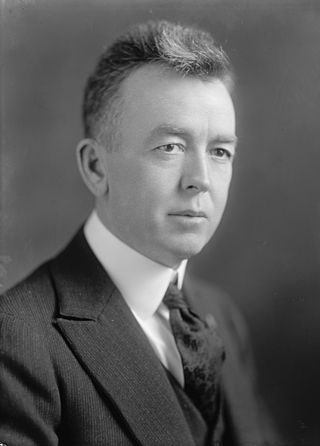
John Elliott Rankin was a Democratic politician from Mississippi who served sixteen terms in the U.S. House of Representatives from 1921 to 1953. He was co-author of the bill for the Tennessee Valley Authority and from 1933 to 1936 he supported the New Deal programs of President Franklin D. Roosevelt, which brought investment and jobs to the South.
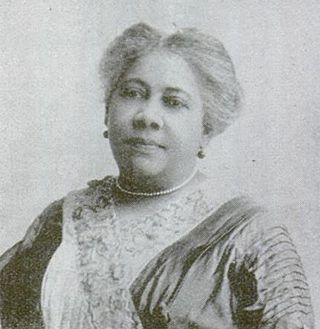
Mary Burnett Talbert was an American orator, activist, suffragist and reformer. In 2005, Talbert was inducted into the National Women's Hall of Fame.

Leonidas Carstarphen Dyer was an American politician, reformer, civil rights activist, and military officer. A Republican, he served eleven terms in the U.S. Congress as a U.S. Representative from Missouri from 1911 to 1933. In 1898, enrolling in the U.S. Army as a private, Dyer served notably in the Spanish–American War; and was promoted to colonel at the war's end.
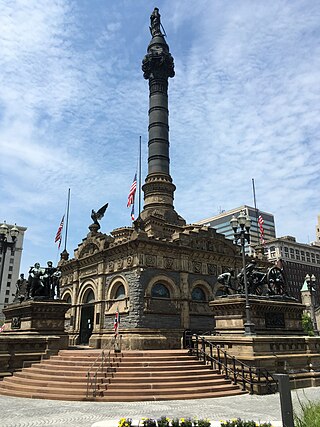
The Cuyahoga County Soldiers' and Sailors' Monument is a major Civil War monument in Cleveland, Ohio, honoring the more than 9,000 individuals from Cuyahoga County who served the Union throughout the war. It was dedicated on July 4, 1894, and is located on the southeast quadrant of Public Square in Downtown Cleveland. It was designed by architect and Civil War veteran Levi Scofield, who also created the monument's sculptures. The monument is regularly open to the public, free of charge.

The National World War I Memorial is a national memorial commemorating the service rendered by members of the United States Armed Forces in World War I. The 2015 National Defense Authorization Act authorized the World War I Centennial Commission to build the memorial in Pershing Park, located at 14th Street and Pennsylvania Avenue NW in Washington, D.C. The park, which has existed since 1981, also contains the John J. Pershing General of the Armies commemorative work. In January 2016, the design commission selected the submission "The Weight of Sacrifice", by a team consisting of Joseph Weishaar, Sabin Howard, Phoebe Lickwar, and GWWO Architects, as the winning design, which is expected to be completed by 2024.

Jessie Daniel Ames was a suffragist and civil rights leader from Texas who helped create the anti-lynching movement in the American South. She was one of the first Southern white women to speak out and work publicly against lynching of African Americans, murders which white men claimed to commit in an effort to protect women's "virtue." Despite risks to her personal safety, Ames stood up to these men and led organized efforts by white women to protest lynchings. She gained 40,000 signatures of Southern white women to oppose lynching, helping change attitudes and bring about a decline in these murders in the 1930s and 1940s.
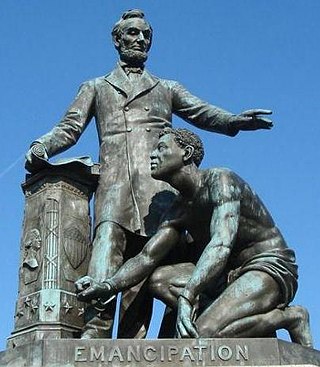
The Emancipation Memorial, also known as the Freedman's Memorial or the Emancipation Group is a monument in Lincoln Park in the Capitol Hill neighborhood of Washington, D.C. It was sometimes referred to as the "Lincoln Memorial" before the more prominent national memorial was dedicated in 1922.
The Lao Veterans of America, Inc., describes itself as a non-profit, non-partisan, non-governmental, veterans organization that represents Lao- and Hmong-American veterans who served in the U.S. clandestine war in the Kingdom of Laos during the Vietnam War as well as their refugee families in the United States.

The Confederate Memorial was a memorial in Arlington National Cemetery in Arlington County, Virginia, in the United States, that commemorated members of the armed forces of the Confederate States of America who died during the American Civil War. Authorized in March 1906, former Confederate soldier and sculptor Moses Jacob Ezekiel was commissioned by the United Daughters of the Confederacy in November 1910 to design the memorial. It was unveiled by President Woodrow Wilson on June 4, 1914, the 106th anniversary of the birth of Jefferson Davis, the President of the Confederate States of America.

All Wars Memorial to Colored Soldiers and Sailors is a war memorial in Philadelphia, Pennsylvania that honors the state's African American servicemen who fought in American conflicts from the American Revolutionary War to World War I. Commissioned by the Commonwealth of Pennsylvania in 1927, it was created by sculptor J. Otto Schweizer and dedicated July 7, 1934. In 1994 it was relocated from a remote site in West Fairmount Park to its present prominent site in Logan Square, along the Benjamin Franklin Parkway.
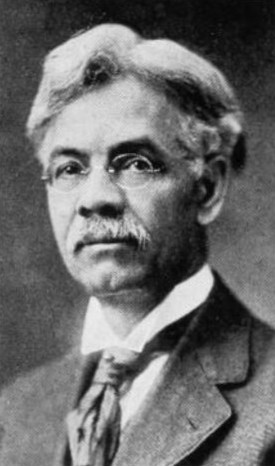
Butler Roland Wilson (1861–1939) was an attorney, civil rights activist, and humanitarian based in Boston, Massachusetts. Born in Georgia, he came to Boston for law school and lived there for the remainder of his life. For over fifty years, he worked to combat racial discrimination in Massachusetts. He was one of the first African-American members of the American Bar Association. Wilson was a founding member and president of the Boston branch of the National Association for the Advancement of Colored People (NAACP).

The Heyward Shepherd monument is a monument in Harpers Ferry, West Virginia, dedicated in 1931. It commemorates Heyward Shepherd, a free black man who was the first person killed during John Brown's raid on Harpers Ferry.
The National Conference on Lynching took place in Carnegie Hall, New York City, May 5–6, 1919. The goal of the conference was to pressure Congress to pass the Dyer Anti-Lynching Bill, sponsored by Leonidas Dyer (R-MO). It was a project of the National Association for the Advancement of Colored People (NAACP), founded in 1909. Recently the group had been working to publicize and try to end the continued lynchings, mostly of black men. In April they released a report, Thirty Years of Lynching in the United States, 1889-1918. The late 19th and early 20th century years were the nadir of race relations, with high rates of violence against blacks, especially in the South, where white Democrat-dominated legislatures had also disenfranchised African Americans during this period, excluding them from the political system.
African Americans in Nebraska or Black Nebraskans are residents of the state of Nebraska who are of African American ancestry. With history in Nebraska from the Lewis and Clark Expedition through the Civil War, emancipation, the Reconstruction era, resurgence of white supremacy with the Ku Klux Klan and Jim Crow Laws, the Civil Right movement, into current times, African Americans have contributed vastly to the economics, culture, and substance of the state.
References
- 1 2 The Time Has Come: Report to the President and to the Congress (PDF) (Report). National Museum of African American History and Culture. 2003-04-02. pp. 7–8. Archived from the original (PDF) on 2015-09-23. Retrieved 2023-02-14.
- ↑ "Alleged to be Misleading: Statement Recently Published Is Corrected by Rev. J. L. White". Evening Star. Washington, District of Columbia. 1916-03-17. p. 5. Retrieved 2023-02-14– via Newspapers.com.
- 1 2 3 4 5 6 7 8 9 Wilkins, Robert L. (2016). Long Road to Hard Truth: The 100-Year Mission to Create the National Museum of African American History and Culture . Proud Legacy Publishing. ISBN 978-0-9979104-1-4. LCCN 2016950268 . Retrieved 2023-02-14.
- ↑ "Shaft to Colored Soldiers". The Washington Post. Washington, District of Columbia. 1916-03-19. p. 3. Retrieved 2023-02-14– via Newspapers.com.
- ↑ "Negroes Want Own Soldiers Monument". Rapid City Journal. Rapid City, South Dakota. 1916-04-18. p. 1. Retrieved 2023-02-14– via Newspapers.com.
- ↑ Hintz, Eric S. (2016-09-15). "An Early Attempt to Build a "National Museum for Colored People"". Lemelson Center for the Study of Invention and Innovation . Retrieved 2023-02-14.